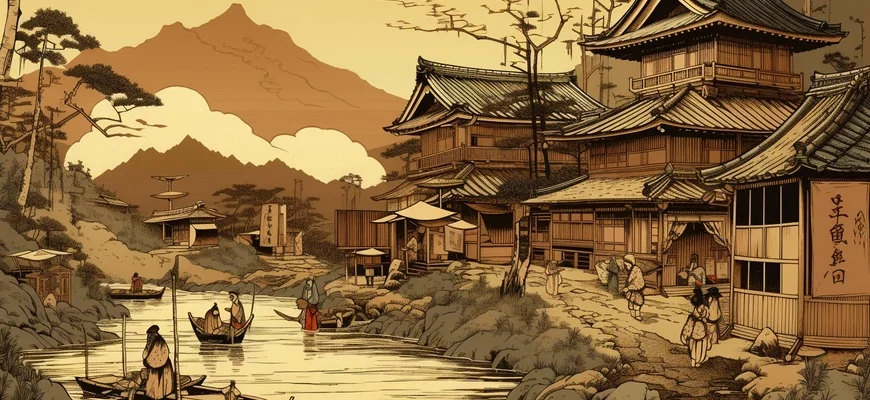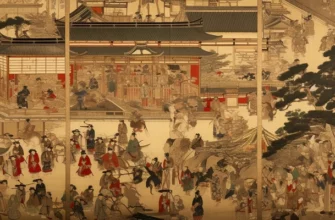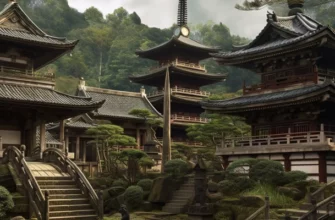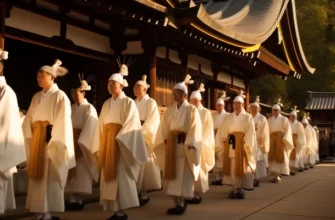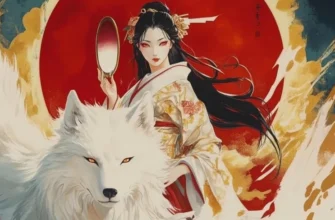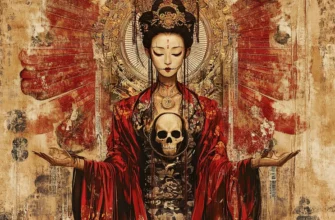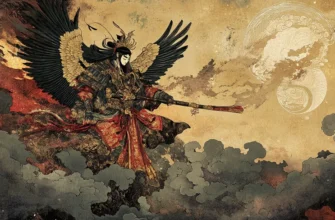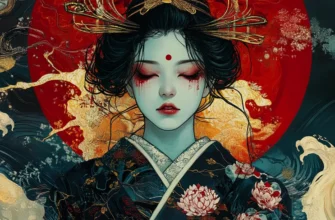Ancient Japanese culture is divided into five periods: Jomon, Yayoi, Kofun, Asuka, and Nara. Each of these periods has its own characteristics in architecture, art, religion, and traditions. For example, the Jomon period is characterized by the use of clay pots and drawings on ceramics. During the Kofun period, burial mounds with distinctive shapes were created. The influence of ancient Japanese culture on modern life is significant, so it is important to preserve and study cultural heritage.
- Jomon period (14,000 BC – 300 BC)
- The development of Jomon culture
- Jomon religion and traditions
- Yayoi period (300 BC – 300 AD)
- The development of Yayoi culture
- Kofun period (300-710 CE)
- Religion and traditions of Kofun
- Asuka and Nara periods (710-794 CE)
- The Development of Asuka and Nara Culture
- Religion and traditions of Asuka and Nara
- Conclusions
Jomon period (14,000 BC – 300 BC)
The Jomon period, which lasted from 14,000 BC to 300 BC, is the earliest period of ancient Japanese culture. The characteristic features of this period are the development of ceramics, the manufacture of clay pots, and a unique artistic technique called “fire sliding.” It is also worth noting that during the Jomon period, hunting and gathering were common, and people lived in tents and caves. Overall, this period formed the foundations of the culture and traditions that have become characteristic of Japan over the centuries.
The development of Jomon culture
The Jomon period (14,000 BC – 300 BC) reflects the development of ancient Japanese culture and art. The main characteristics of this period are the production of ceramics, ceramic painting, complex systems of ritual ceremonies and ritual tools, as well as living in tents and caves. Jomon craftsmen made pottery, toys, and jewelry from clay, and also used an original technique of painting with brushes. At the same time, during the Jomon period, fire began to be used as a tool for processing and painting wood, creating unique works of art. In general, the Jomon period has a significant influence on modern Japan, as it formed the foundations of the culture and traditions of the Japanese people.
Jomon religion and traditions
The religious and traditional beliefs of the Jomon period (14,000 BC – 300 BC) reflect the deep connection between humans and nature. It was believed that every object had a soul and that every spirit of nature deserved respect and worship. At the same time, the Jomon period saw the development of complex systems of ritual ceremonies and tools associated with spirit worship and ensuring the well-being of the community. Traditional tools, such as stone circles and sticks, were used to summon deities and ensure their presence during ceremonies. According to Jomon spiritual beliefs, humans had to be in tune with nature and worship it in order to ensure harmony and well-being.
Yayoi period (300 BC – 300 AD)
The Yayoi period (300 BC – 300 AD) reflects the next stage in the development of Japanese culture and society. During this period, the formation of the state began, judicial and writing systems appeared, and many reforms were carried out in the political and social spheres. Japanese society became more hierarchical, new social classes and professions emerged, and trade and crafts developed. The art of the Yayoi period, particularly sculpture and wall painting, reflected new Christian and Buddhist influences. This period is an important stage in Japanese history, as it defined many aspects of Japanese culture and society that still exist today.
The development of Yayoi culture
During the Yayoi period (300 BC – 300 AD), important changes took place in Japanese culture. The first writing systems were created during this period, allowing information to be recorded and passed on to future generations. The construction of temples and sacred sites began, leading to the development of architecture and sculpture. In the art of the Yayoi period, much attention was paid to detail and realism. Most images depicted military themes, animals, and natural elements. Literature also developed, with new legends and myths appearing, as well as the first collections of poetry. During this period, there was significant development in trade and crafts, which was reflected in the culture. Overall, the Yayoi period played an important role in the formation and development of Japanese culture and society.
During the Yayoi period, religion played an important role in the lives of the Japanese people. New religious rites and ideologies, such as Shinto and Buddhism, were created, which played a major role in shaping Japanese culture and society. Buddhism came to Japan from Korea and China, while Shintoism was created in Japan. Shintoism only became the official religion of Japan in 1868, but its fundamental ideas and rituals date back to the Yayoi period. The cult of Shintoism was reflected in the art, architecture, and daily life of the people. The traditions that took shape during the Yayoi period became the foundation for the further development of Japanese culture and society. H2: Kofun period (300-710 CE)
Kofun period (300-710 CE)
The Kofun period (300-710 AD) was marked by significant changes in Japanese culture and society. At the beginning of the Kofun period, Japanese society was strongly influenced by the cultures of Korea and China. Over time, Japanese culture developed in its own way, creating new forms of art and architecture. For example, burial mounds (kofun) were created, which became a characteristic feature of the period. At this time, hieroglyphs borrowed from Chinese writing began to be used, which was an important step in the history of the development of Japanese writing. Religion remained an important part of culture, and many new religious ideologies and rituals were created during this period. The Kofun period was an important stage in the formation of Japanese culture, laying the foundations for the country’s further development.
Religion and traditions of Kofun
During the Kofun period in Japan, religion occupied an important place in culture and society. Many new religious ideologies and rituals were developed, which played an important role in the formation of Japanese culture. One of the most influential cults of the time, the cult of the sun, was popular among rulers and nobles, as well as among ordinary people. Buddhism and Confucianism also began to spread, playing a significant role in shaping the moral values and worldview of the Japanese people. The Kofun period also saw the emergence of new traditions and customs, such as pottery and blacksmithing, which later became integral parts of Japanese culture.
Asuka and Nara periods (710-794 CE)
The Asuka and Nara periods in Japan were characterized by significant changes in culture and society. During this period, Japan underwent a painful reform – Taika, which included the introduction of Chinese ideas and customs. New ideas and technologies led to a significant enrichment of Japanese culture and knowledge, which played an important role in the further development of the country. During this period, new technologies such as improved agriculture, paper manufacturing, and writing developed, which greatly improved the exchange of knowledge and information in Japan. The religious system of the period was Buddhism, which penetrated Japanese culture from China and Korea. Buddhism became an integral part of Japanese culture, which was reflected in art, architecture, and other aspects of people’s lives.
The Development of Asuka and Nara Culture
The Asuka and Nara periods in Japan are known for their significant cultural development. Under the influence of Chinese and Korean cultures, new technologies such as paper manufacturing and writing developed, which greatly improved the exchange of knowledge and information in Japan. During this period, art and architecture also developed, strongly influenced by Chinese and Korean traditions. Buddhism became an integral part of Japanese culture, reflected in art, architecture, and other aspects of people’s lives. The religious system of the period also underwent changes – Shintoism began to develop alongside Buddhism and became an important part of Japanese culture.
Religion and traditions of Asuka and Nara
During the Asuka and Nara periods, new religious beliefs began to appear in Japan, which were associated with ties to China and Korea. One of the most important religious movements that emerged during this period was Buddhism. Buddhism became an integral part of Japanese culture and had a significant impact on art, literature, and other areas of people’s lives.
Shintoism, the traditional Japanese religion, also developed during this period. Shintoism was associated with beliefs in nature and ancestor worship, and it became an important part of Japanese culture.
In addition to religion, traditions also developed during the Asuka and Nara periods. For example, Zen gardens, special gardens created for meditation and concentration, appeared at this time. Tea ceremonies also developed during this period and became an important part of Japanese culture and art.
Conclusions
Ancient Japanese culture continues to influence modern Japan and the world. Modern technology and innovation are combined with traditional Japanese values and religious beliefs. Many of the traditions and rituals that originated in ancient times have survived to the present day and have become part of modern culture.
Preserving and researching cultural heritage is important for preserving the country’s history and traditions. Studying ancient Japanese culture provides an opportunity to better understand the country’s past and the development of its modern culture. Preserving cultural heritage and promoting it also contributes to the development of tourism and international relations.
Thus, ancient Japanese culture continues to influence the modern world, and preserving and studying cultural heritage is important for preserving the country’s history and traditions.
